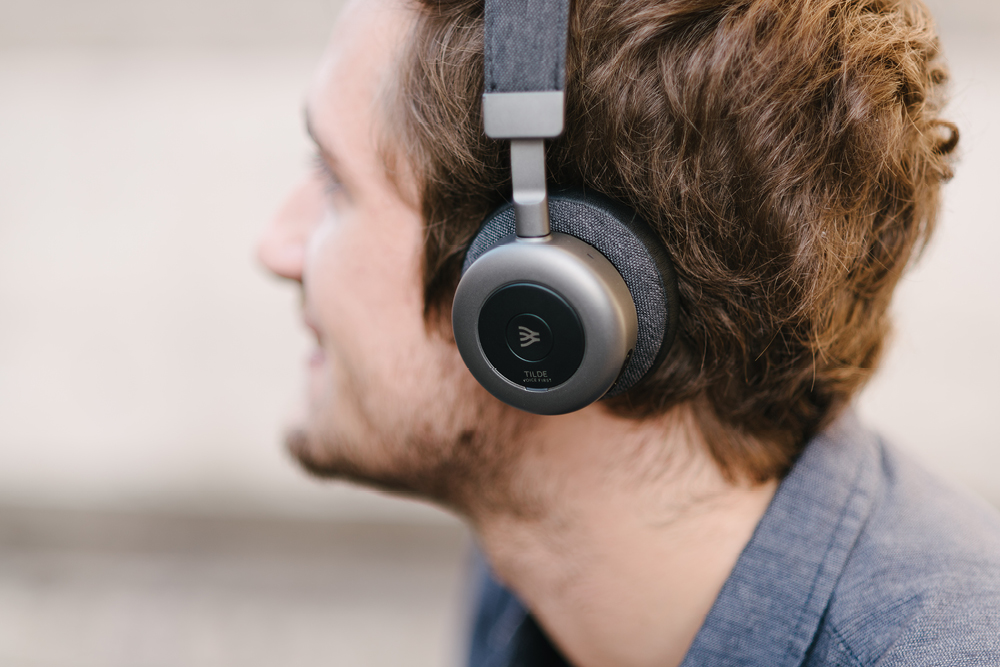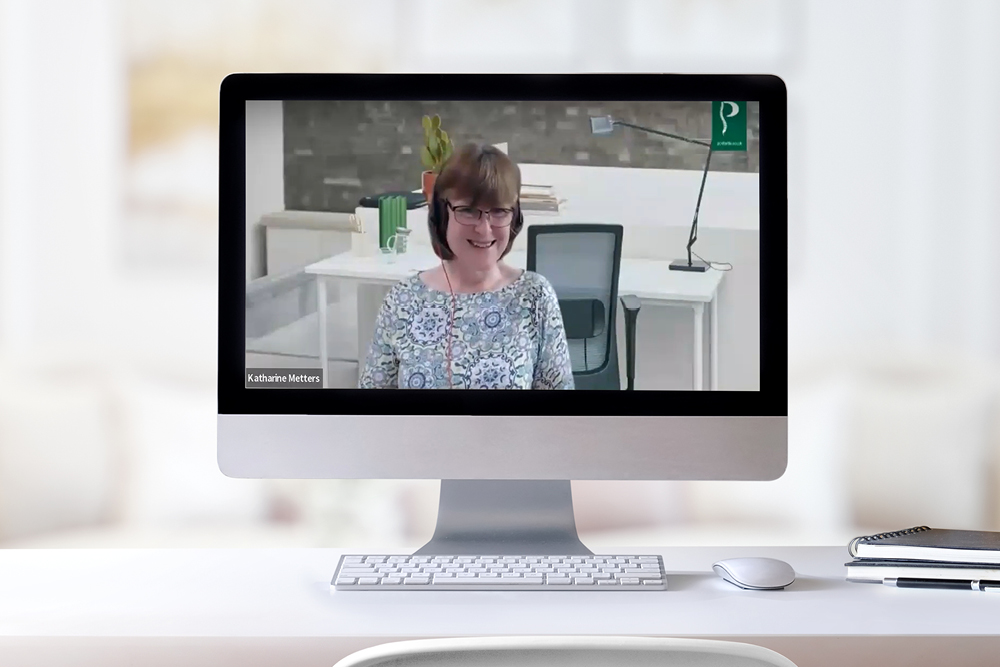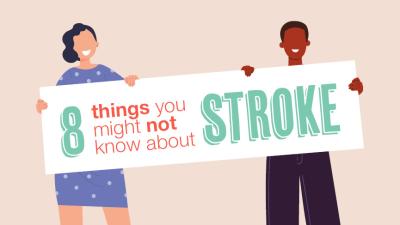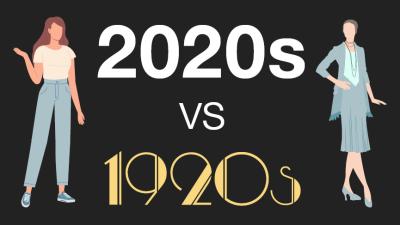Those of you who’ve seen me looking like I’ve been dragged through a bush backwards in a Teams meeting, will wonder what qualifies me to write this blog.
Well, I want to learn too. So I’ve consulted experts in this matter to share advice on communicating confidently from your home office headquarters. In this article I’ll help you consider your positioning, lighting, personal presentation and voice for virtual meetings.

The improvements that you made in the first months of enforced homeworking aren’t enough to see you through a decade of remote working. In the same way that your Mum bravely got to grips with her Zoom account in the year 2020, it’s now time to polish up your act and put your best foot forward – on the screen.
“Yes, it’s officially time to address virtual professionalism at work” said CEO World in 2023.
Preparing for video meetings
“Think of yourself as a picture sitting there” advises Rosalind Perrin, HR Manager for Posturite. “That initial view is really important so you've got to spend time to prepare. Get the sound right, get the image right and think about your background.”
Take the time to refresh your setup by doing a test call (see instructions at the end of this article) to play with your settings and optimise how you look on camera.
“In a virtual world, performing well on camera can be game changing for how your message lands, the impact you have, how people relate to you, trust you and buy into you” says Louise Goss from thehomeworker.com. She holds masterclasses on how to present and engage on camera. “It could be the difference between you landing the job, the promotion, getting the sale, or having the positive outcome you’re looking for - or not.”
If you’re hosting a meeting, especially a larger meeting, it’s important to ensure everyone will be included. This can be tricky if there’s a mix of dominant and more reserved characters in your group. It’s good to always make sure everyone has an input at the start of the meeting and you could encourage a variety of methods to contribute - such as the chat function, reactions and using a virtual white board.
Your positioning at your desk for video meetings
Remember that the key starting point is your workstation set up – both at home and at a workplace – so you’re working in the most suitable ergonomic position for the task you’re doing. This of course helps prevent aches and pains, and boosts your productivity and comfort. You’ll be more confident if you’re comfortable! Check the Posturite guide to making small positioning changes that count.
But you can optimise how you look on screen at the same time too, without compromising ergonomics. Position the monitor or laptop screen around an arm’s length in front of you, meaning that when you’re on camera you’re looking straight into the camera and are only visible from the shoulders up. It’s ideal to have your computer camera around eye level, or just above it. Try not to position the camera at lap level so you’re looking down. The people you’re meeting to hear your pearls of wisdom would then have to look up your nose or up at your chin.
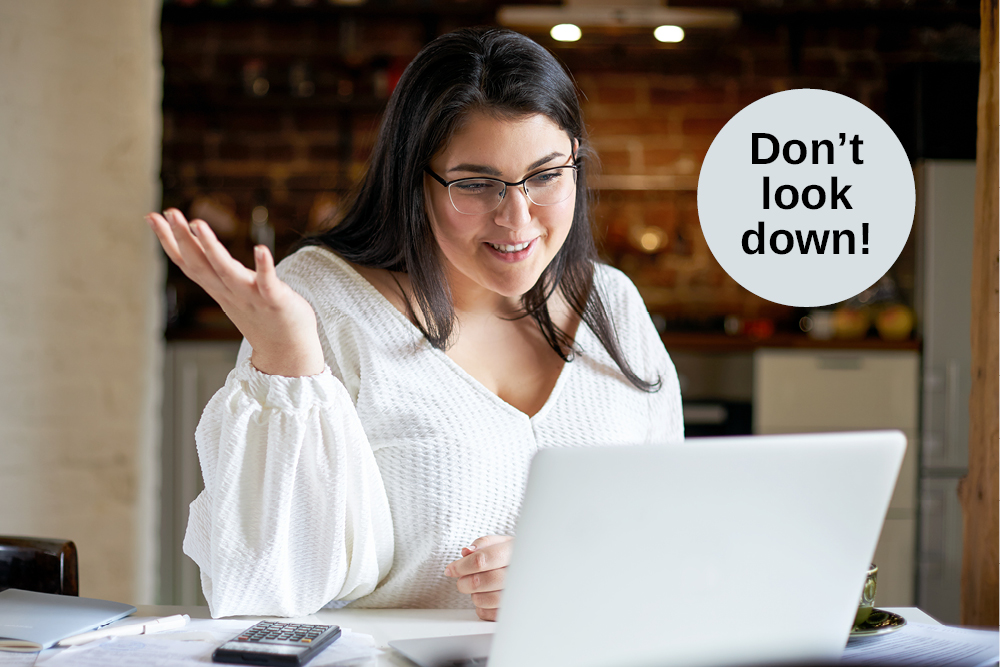
YouTuber Gia Goodrich also advises tilting your laptop screen just a little (the top towards you) for a flattering camera angle, but after you’ve finished your call remember to readjust your screen for your other tasks. Your screen should be slightly tilted upwards for your eye health and posture. (You could use a separate webcam to save making frequent changes.)
I use a laptop stand to help my sitting posture and prevent me hunching over, looking down at my laptop and this also positions my computer camera perfectly.
If you use a monitor, a great option is of course to use a monitor arm to position your screen just right.
I beg you too not to forget that sitting-working is not the only kind of working! Many people now use a height-adjustable desk or platform to stand to work and numerous colleagues say the simple act of standing to participate in a meeting or to deliver presentation from home helps to give them confidence. You might find that standing gives you gravitas! (Meet the people who love sit-stand working here by the way.)
Your lighting in video meetings
If you are well lit then this helps you to communicate online as your colleagues and clients can pick up the more subtle clues from your facial expressions.
I’d always heard about how much of a difference lighting makes to your appearance in virtual meetings but it has taken writing this blog to investigate it properly!
Having to look at myself talking on screen all the time was for me a big adjustment in 2020! Ugghh, some days that is no fun. Your work itself is of course far more important than how you look at work, but if you can FEEL more confident and you have better self-esteem, then that is no bad thing for some of us.
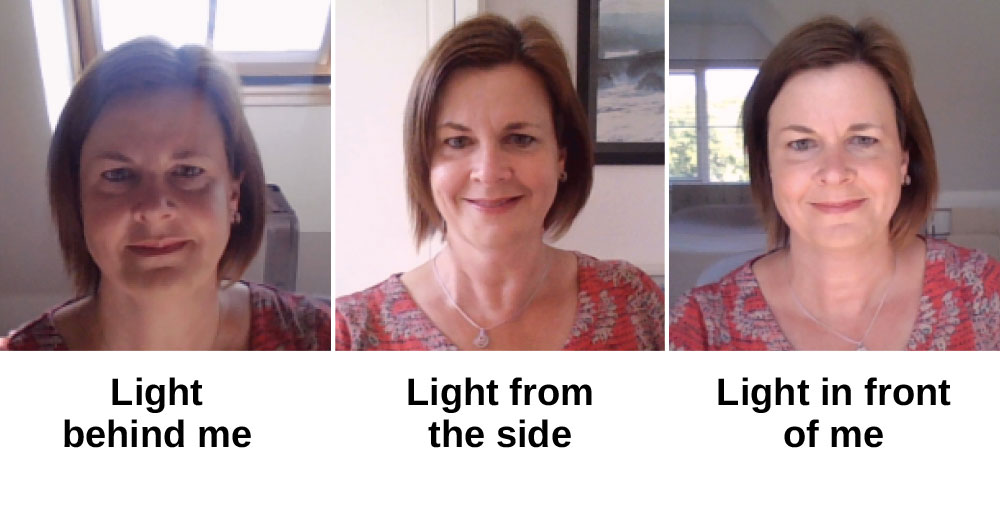
If you can, for video meetings avoid:
- Having your back to the window
- Having light from the side. (However this lighting is helpful to help prevent eye strain when you’re working and not in meetings, so think about closing your blinds for video calls.)
Instead the best thing to do is to turn toward a big, soft light source. You want to evenly light your face and ensure there's some light in the background too. (I read that you can soften and diffuse this light from a window with net curtains – but really? Net curtains are a bit 1985… so you could use a Voile or daylight blind.)
Next, I tried a ring light! For your benefit only, I have road-tested the Neewer RP10-H ring light because at a Digital Women event years ago I remembered ring lights being a top tip.
I placed the ring light centrally behind and above my laptop (which is on a laptop stand). People won’t know you’re using one.
Take a look at the results:
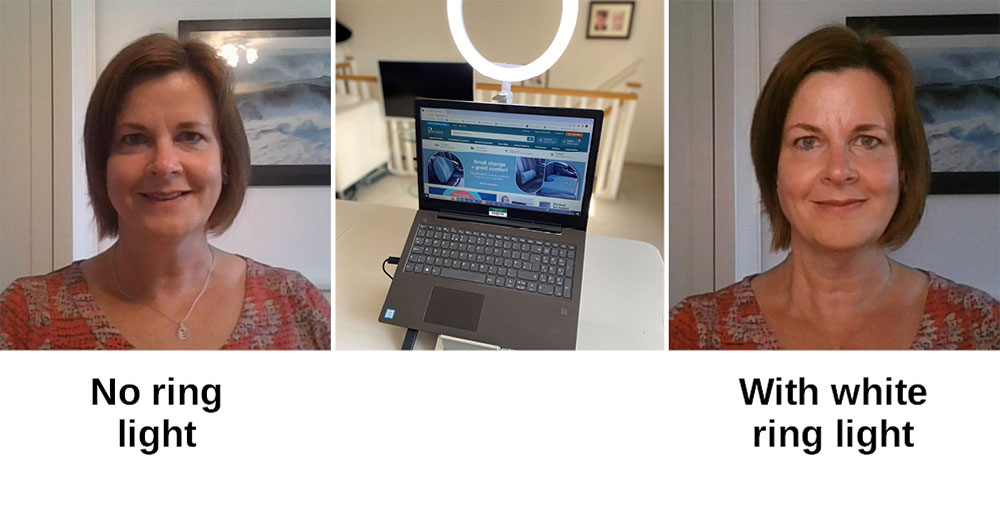 My conclusion? I will definitely use the ring light for important meetings because it does give a professional look and the flattering result may well give me more personal confidence - but it’s too bright and ‘in-your-face’ to use for every online meeting several times a day.
My conclusion? I will definitely use the ring light for important meetings because it does give a professional look and the flattering result may well give me more personal confidence - but it’s too bright and ‘in-your-face’ to use for every online meeting several times a day.
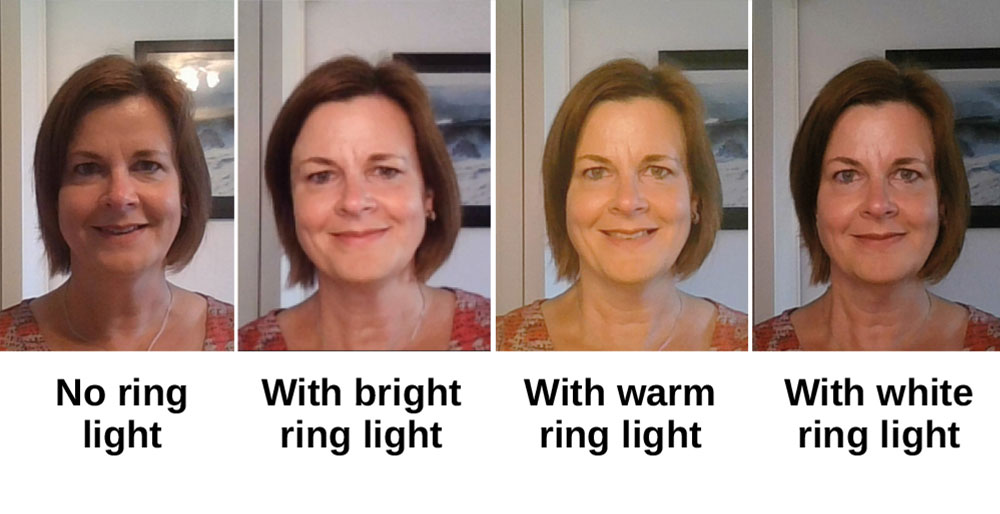
Your voice in video meetings
HR Manager Rosalind likes to warm her voice up before an important virtual meeting - just by doing some humming - and this is a good idea particularly if you've not spoken to anybody yet that day.
Remember not to rush what you’re saying. Be bold and have the self-belief that what you’re saying is of value.
A professional headset will give you much crisper audio in your meetings and your attendees will enjoy a far better quality experience of your voice. The headset also helps you focus by blocking out background noise.
Voice Coach Sharon Stacey recommends that you seek to ‘own the space’ in a meeting. She says “Part of using your voice confidently is about feeling confident in yourself and your place in the meeting. Many female leaders I coach struggle with self-doubt and imposter feelings. Before challenging meetings, I encourage you to remind yourself of your expertise and the contribution you make. Try to step into the authority of your role.”
Sharon advises a technique called ‘Chest Voice Resonance’. She says that many women speak from higher up, above their neck, which means they never use the full power of their voice:
“Instead, imagine your voice is coming from the lower part of your belly and sync it with your breath, which should also be in your belly. As you breath out, you speak. To help with this, try practicing a few sentences with your hand of your chest. Feel the vibrations there when you’re focusing on speaking and breathing from your belly, and speaking on each breath.”
I’d recommend the Carla Miller Training podcasts for more on this theme of conveying confidence.
Your appearance in video meetings

“Do your hair, get your glad rags on!” requests HR Manager Rosalind, and this doesn’t just apply to job interviews. Present yourself as if you would if you were coming into work face to face.
If you’re a little unprofessional in the way you dress, you could risk offending the person you’re meeting if it comes across that you’ve decided they are unimportant. It depends of course on your field of work and role.
Back in 2020 a LinkedIn poll found that 42% of homeworkers owned a ‘Zoom shirt’ or blouse which they kept at hand to quickly slip on just for the duration of the meeting. This is still not a bad idea.
Recruitment Adviser Trish Riley tells me she has interviewed people online who “look like they've just rolled out of bed”! She says casualwear is fine, but she does want to see an effort to look presentable.
There is some weird advice on virtual meeting fashion out there! One article says “Solid, neutral colours like lavender, lemon yellow, and beige are the best colours to wear on camera” but as someone who is not a Skinny Minnie this sounds horrifically unflattering to me, for women anyway.
I personally like to wear a warm colour as it boosts my mood a little and often a bright colour, a pattern and some statement jewellery is fine. My colleague Katharine Metters (pictured below) is a seasoned webinar presenter and I admire the way she presents herself on screen as Lead Consultant at Posturite – for example the clean lines of her fitted round-necked top shown below work well and the pattern adds interest without being distracting. It’s her posture and body language of course which is most effective! It does express confidence to adopt an upright, open posture when speaking online.
Katharine says she always looks carefully at her diary on the days when she is working away from home to decide what to wear to ensure she’s presentable if she’s needed on screen. Its not the same as being at home where if plans change and a video meeting is needed you can quickly go and change! She is also a fan of a necklace to brighten up a sensible choice of top!
Your background in video meetings
I don’t believe you have to have very bland backgrounds – unless you have a very serious job – it can be friendly to see something suitable behind you which adds interest to your meetings and helps your colleagues get to know you.
Hopefully the tech powers that be will soon be able to resolve that weird halo effect you get when you blur your background. I know this feature is handy for many people working from home to preserve the privacy of their home.
I won’t be the only homeworker who has a bed in view behind them on the screen of their video calls. It’s not ideal but OK in my role I believe (as long as the bed is made very neatly!). It’s really easy to create a JPEG to use as a company background image, so do explore this as a better option.
So I hope the suggestions in this blog will help you. We’re all learning together and evolving as long-term homeworkers in this era of rapid and dramatic shifts in working culture.
*To do a test video call
In Microsoft Teams do this by selecting ‘Settings’ in the three dots next to your profile picture at the top and then choosing ‘Devices’. Scroll down to find the ‘Make a test call’ button there or use the ‘Preview’ feature in that same section.
In Zoom, just go to https://zoom.us/test and click ‘Join’ or click your profile picture, then ‘Settings’ and the ‘Video’ tab to see a preview video.





